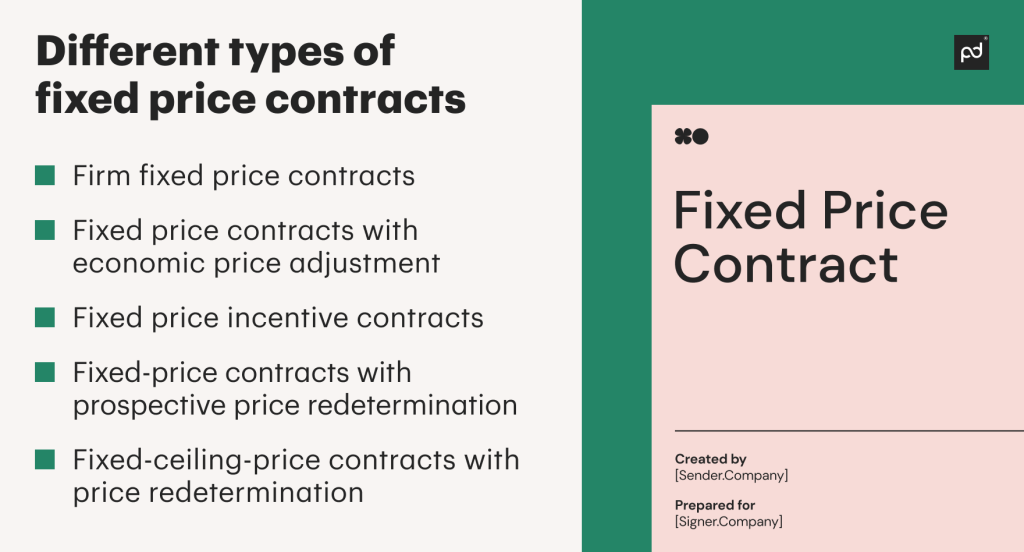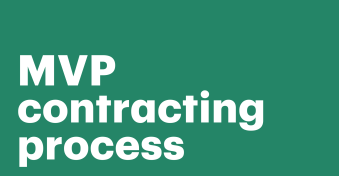Ever contracted a project manager, gotten a reasonable estimated price, and then been hit with a huge markup at the end of the job for unforeseen expenses?
It probably left you wishing you’d considered a fixed-price contract.
For many business owners, this scenario is a real problem. Contracts can be complex and demanding, even for the best legal teams.
In this post, we’ll talk about the benefits and disadvantages of fixed-price contracts, why they’re worth considering, and how you can efficiently handle fixed contract lifecycle management.
Key takeaways:
- Fixed-price contracts between a buyer and seller guarantee a predetermined price for a product or service.
- They provide a level of certainty for both parties and keep things reasonably simple.
- Fixed-price contracts tend to favour the buyer, so sellers should ensure that such a contract is suitable for whatever they’re trading.
- Sellers need to ask themselves if they can fulfill the contract obligations and still make a profit and ensure they’re accounting for inflation.
- A robust contract template can make the process of creating a fixed-price contract much more straightforward.
What exactly is a fixed-price contract?
A fixed price contract (sometimes called a fixed rate contract, fixed fee contract, firm fixed price contract, or FFP contract) is an agreement with a predetermined cost.
The buyer and seller agree on a fixed price agreement upfront, and nothing can change that price.
Fixed price contracts are best used when the cost of the project or goods can be determined upfront.
An example is office supplies – the buyer knows exactly what they need to stock their office, and the seller can calculate the exact cost of the goods and shipping.
The deal doesn’t need to be any more complicated than that.
However, this kind of agreement might not work for something like a building contract, where material costs can vary, time delays are common, and unforeseen circumstances are almost inevitable.
Understanding the significance of fixed-price contracts
Ever wanted to lock in the price of something while it’s good? Then you can understand the significance of a fixed-price contract.
A firm fixed price can greatly benefit a buyer since they have price certainty no matter the circumstances.
Sellers, however, can put themselves at risk. For example, you’re a web developer offering a fixed fee contract per website to attract new clients.
A fixed fee is a real draw for a buyer who wants to avoid spiraling costs, so you get an immediate hit.
It’s a simple enough job on the surface, so you get to work on the website.
But the buyer has changed their mind about something.
And then they’ve had an exciting idea they’d like you to add!
And then the color scheme isn’t quite right…
Before you know it, the numbers are not adding up.
You’ve spent more hours on the website than even the lowest minimum wage entitles you to and even the best client review won’t balance the books.
If you’re the buyer in this scenario, though, you’re at an advantage.
Fixed fee contracts can significantly impact a buyer or seller’s bottom line, for better or for worse.
This is why it’s so important to use fixed-rate contracts properly – only when goods or services can be accurately calculated upfront with a great degree of certainty.
Benefits and drawbacks of fixed-price contracts
Let’s dive deeper into the benefits and drawbacks of fixed-price contracts.
Benefits
- Certainty: Fixed price contracts provide a high degree of confidence on both sides. Each stakeholder understands their part, the costs associated, and the dates involved. Since everything is determined upfront, there is no wiggle room.
- Simplicity: FFP contracts are easier to create, monitor, and renew, requiring less administrative work. They also tend to be fairly standardized, so you can use standard business document templates to draft them.
- Budgeting: Knowing all the terms upfront makes budgeting simpler.
- Accounting: Similarly, accounting can plan for exact incomings and outgoings.
- Inventory: The buyer knows exactly what they need, and the seller knows exactly what they’re shipping.
Drawbacks
For the seller
- Risks: We’ve briefly discussed the risks already, but it’s important to highlight that a fixed fee contract can put sellers at risk of losing out.
- Profit: Since the price is fixed, any unforeseen circumstances don’t affect the buyer. But the seller’s job can be affected by delays, project complexity, material costs, labor shortages, or any other kind of issue. The seller must fulfill the contract for the price negotiated, regardless of negative effects on profits.
- Scope: Projects are notoriously tricky to plan. The scope and direction of a project can change on a dime, so fixed terms can stifle a lot of that flexibility.
For the buyer
- Price: Sellers may raise prices to account for the risk to their profits, negatively impacting buyers.
Different types of fixed price contracts

Firm fixed price contracts
An FFP contract, for short. A standard fixed-price contract. Buyer and seller agree on terms, and those terms must be met.
The seller assumes most of the risk, as they must deliver the work in the time stated regardless of unforeseen circumstances or impact on profits.
The whole point of a firm fixed price contract is to, well, offer a firm fixed price no matter what.
Fixed price contracts with economic price adjustment
Or FP-EPA for short. These contracts can take some of the burden off the seller, as they allow for some reasonable price adjustments based on inflation or fluctuating material costs.
FP-EPAs can be useful during times of financial instability, where there are serious concerns about the cost of materials and labor, as well as the impact of inflation.
Any terms of these adjustments should be thoroughly outlined in the contract.
Fixed price incentive contracts
These are fixed price agreements with some incentives.
They can benefit both the buyer and the seller by offering encouragement for exceptional or timely work. This can foster a good working relationship between both parties.
For example, the buyer might offer a bonus to the seller for finishing a project early.
Alternatively, the buyer can impose penalties for late delivery.
Fixed-price contracts with prospective price redetermination
This variation of a fixed-price contract allows for future price renegotiation.
So the contract begins with a fixed price for a predetermined amount of time, and once that period ends, the situation is reassessed.
This can mitigate risks for both buyer and seller.
The seller is incentivized to produce high-quality work or goods for a chance at raising their fee.
If the seller is fulfilling all the terms of their contract to a high degree, they can renegotiate from a position of strength, potentially for greater profits.
Alternatively, if a seller has realized that the terms of the contract are eating into their profits, they have a chance to fix it.
If the buyer isn’t happy with the quality of the seller’s work, they can renegotiate for a lower fee.
Fixed-ceiling-price contracts with price redetermination
These are similar to the above contracts, except they have a ceiling–the maximum amount a buyer is willing to negotiate up to.
This fixed ceiling can offer a greater degree of certainty for both buyer and seller.
Fixed-price contracting and management
Managing firm fixed-price contracts can be tricky, so it’s important to follow a few steps to mitigate risks.
Assess
Determine whether a fixed fee contract is right for your situation and if so, which type of agreement works best.
Buyers, in particular, should determine if they can meet the terms of the agreement in time and for a reasonable profit.
Responsibilities
Outline buyer and seller responsibilities.
This includes the service or goods required and the timeframe for completion.
Estimate costs
This is the tricky part. To the greatest degree possible, try to determine every cost eventuality, from materials to manpower.
Identify potential issues
Every job has those pesky unforeseen circumstances we keep talking about.
Both parties need to identify what could go wrong and account for it.
Work out a price
Based on the seller’s estimated costs and a thorough risk assessment on both sides, both parties should have a good idea of a reasonable fee.
Negotiate
Both parties can negotiate the contract until each side is comfortable with the terms.
Outline contingencies
Plan for changes, like an emergency arising or one party of the contract being unable to fulfill their obligations.
Outline a process for handling these changes upfront, and it will be easier to work towards a resolution.
Communicate
It’s vital to stay in communication.
Whether you’re a buyer or seller, you don’t want your contract to fall apart or your business relationship to deteriorate.
Communicating eliminates the risk of friction, delays, and failure.
Make sure both parties have access to the contract so they can monitor progress and schedule regular meetings to keep things up to date.
How to make a fixed-price contract
Now you know the basics of a fixed-price contract, let’s take a look at how to create a contract.
Identify your needs
It might sound obvious, but the first step is identifying the need for the contract. Are you a buyer looking for office supplies?
Are you a seller of top-notch ballpoint pens, and staplers that never get stuck right when you need them?
Define those needs
Now that you know what you need, it’s important to define it.
A buyer should know exactly how much paper and how many pens and staplers they need to supply their office.
A seller should know their inventory, how much they can ship, and the associated costs.
Negotiation price and payment schedule
As we discussed above, sellers should estimate all the costs involved with fulfilling the contract and relay that information to the buyer.
The buyer can then determine whether they’re willing to pay those costs.
If not, both parties can negotiate until they’re satisfied.
Terms
Next, legal teams can outline all of the terms of the fixed price agreement. This holds each party accountable for their role, whether that’s paying on time or delivering on time.
Breach of contract clauses
Best case scenario: all the terms of your contract are fulfilled perfectly.
But we all know life likes to throw curveballs. And when it does, it’s vital to have breach of contract clauses.
If one party cannot fulfill its obligations, these clauses outline what happens next.
This might be extra time granted to make up for mistakes, fines incurred, lawsuit jurisdiction, or how to calculate damages.
Liability limitations
You can mitigate a sticky situation by including reasonable liability limitations.
This gives each party some leeway if their obligations can’t be fulfilled for genuine, provable reasons.
Liability limitations can also cap how much a company can recoup on losses.
If a seller cannot produce for reasons outside of their control, a buyer can only demand a limited amount of compensation set by the terms of the contract.
Warranty
To ensure buyers feel secure in their purchase, a warranty should be outlined in the agreement.
This is a set period of time where the seller will cover any issues, such as physical breakage or technical problems.
If a seller doesn’t want to include a warranty for any reason, this should be clearly disclaimed in the contract.
Returns
If the seller chooses to have a return policy, they should state the terms.
How long does the buyer have to request a return? And how should these requests be handled to ensure good reasoning?
Important factors to consider when drafting a fixed-price contract
As a seller
- You are shouldering most of the risk; are you prepared to handle that?
- Can you fulfill the contract obligations and still make a profit?
- Can you accurately estimate the cost of your materials, time, and labor?
- Are you accounting for inflation and the cost of materials and manpower?
- If this contract is long-term, is there room for future renegotiation?
As a buyer
- Are your needs simple enough to be fulfilled by a straightforward firm fixed price contract?
- Would you benefit from another variety of fixed-rate contract?
- Are you getting the best prices for your goods or services?
- Can a variable contract offer better prices, despite the uncertainty?
For both parties
- Contracts can be complex–do you have an efficient contract management system in place?
- Can both parties track the contract easily and securely?
- Are the terms of the contract being met on schedule? And if not, can you pinpoint why?
Fixed price contract template example
If you’re uncertain about any aspect of fixed price contracts, don’t be afraid to try templates.
You don’t have to be a legal genius at drafting contracts from scratch to use them effectively!
Take a look at this fixed-price contract template from PandaDoc as a good example.
Create a winning contract using PandaDoc contract templates
On the surface, fixed-price contracts are quick and easy.
They offer buyers and sellers certainty and simplicity and are the go-to option when the cost of the product or service can be determined upfront.
But don’t underestimate the work that goes into producing them.
Sellers need to be sure they are the best option for the arrangement they’re entering into and be wary of the potential risks.
If you’re considering a fixed-price contract and need a starting point, try PandaDoc free for 14 days.
And not just for fixed-price contracts.
PandaDoc offers a wide range of solutions for contract management, including contract tracking systems, eSignature security, and a variety of integrations.
Disclaimer
PandaDoc is not a law firm, or a substitute for an attorney or law firm. This page is not intended to and does not provide legal advice. Should you have legal questions on the validity of e-signatures or digital signatures and the enforceability thereof, please consult with an attorney or law firm. Use of PandaDocs services are governed by our Terms of Use and Privacy Policy.


